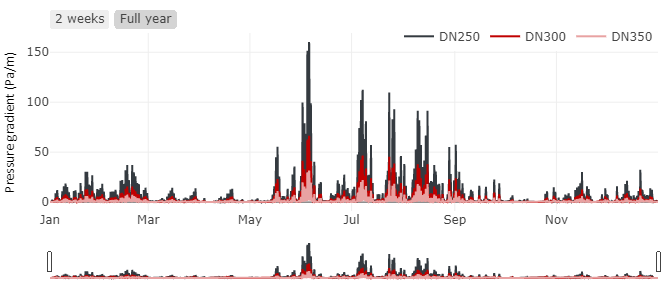nPro: The design tool for 5th generation district heating and cooling (5GDHC) networks
nPro was developed specifically for the design of 5GDHC networks. In the following, you learn more about how nPro simplifies the planning process for districts with 5GDHC networks.
Simulation of demand profiles for buildings in cold district heating networks
The simulation of energy demand profiles, e.g. for space heat or domestic hot water, is often complex and different simulation tools have to be used in the process. Alternatively, simplified calculation methods in spreadsheet programs, such as Excel, are often used, which contain strong simplifications. The design tool of nPro, on the other hand, allows to generate consistent annual profiles for different energy demands with hourly resolution. These can be generated for defined building standards and annual consumptions. If no annual consumption data is available, the literature values stored in the nPro tool can be used for a variety of different building types. The stored demand data are based on standards and scientific simulation studies and are available individually for many city worldwide.
Dimensioning of pipe diameters for 5GDHC networks (cold district heating)
nPro is one of the first simulation tools to offer support in the design of pipe networks for 5GDHC networks. After all buildings have been composed to a district, the individual pipe connections between buildings and the energy center can be designed and dimensioned in nPro. Here, hourly resolved pressure loss profiles are calculated on the basis of the building demands for each pipe section. nPro then suggests three possible pipe diameters on the basis of the pressure loss profiles. Key figures are then calculated for all three diameters, such as the specific pumping work, the maximum pressure gradient occurring over the year, the maximum flow velocities and volume flows. Based on this information, a pipe diameter can be selected for the specific network section depending on the design preference. Figure 1 shows an example of the design of a pipe diameter with the three diameters proposed by nPro. Diversity factors of the district heating networks can also be taken into account in the calculation.

Planning of energy centers for 5GDHC networks (cold district heating)
In nPro, common generation and storage technologies can be considered for the design of the energy center for 5GDHC networks. These include geothermal energy, reversible air-source heat pumps for heating or cooling, waste heat sources, cooling sources, compression chillers, solar thermal collectors, or photovoltaic modules. In addition, to store heating and cooling demands, 5GDHC-specific water-filled storages can be used which allow to store heat or cold, depending on the demand situation in the 5GDHC network.
This might also interest you
nPro software
Plan your energy system with nPro!

 English
English
 Deutsch
Deutsch


